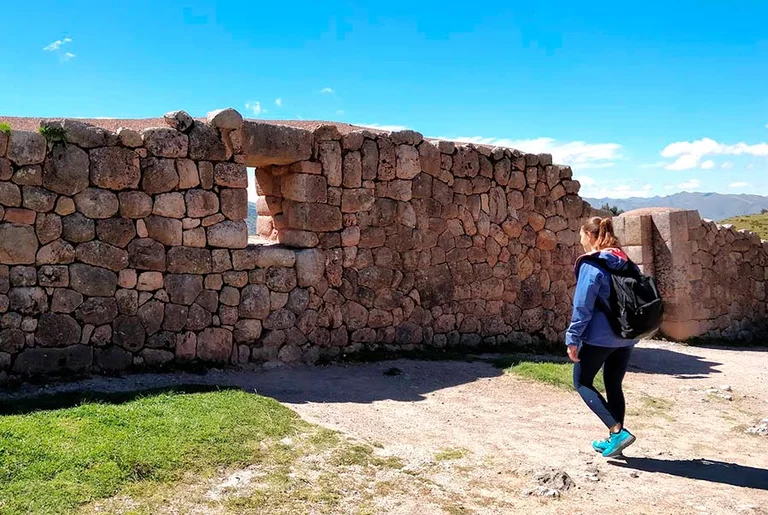
November 11, 2025
Puka Pukara: what no one tells you before visiting
Puka Pukara often goes unnoticed on the City Tour, but there are details you should know before visiting. How far away is it really? How much time do you need? Is there something most tourists miss? In this blog, we tell you what no one warns you about, with useful tips to make your visit truly worthwhile.
History and architecture
When was Puka Pukara built?
Puka Pukara was built during the expansion period of the Inca Empire, probably in the 15th century, under the rule of Inca Pachacútec. This era was characterized by the development of a network of roads, tambos, and administrative centers that allowed for greater organization of the conquered territory.
Although there is no exact date, archaeological studies and comparisons with other nearby constructions indicate that this fortress was built in an advanced stage of Inca development. Its proximity to other important sites such as Tambomachay also reinforces the idea that Puka Pukara was part of a planned system of control and surveillance for access to the capital of the Tahuantinsuyo, Cusco.
What was Puka Pukara’s role in the Inca Empire?
Puka Pukara fulfilled multiple functions within the Inca administrative and military system. Its main use was probably as a control and surveillance post, due to its elevated location overlooking the roads leading to Cusco.
In addition to its military purpose, it is believed that Puka Pukara also served as a tambo — a resting place for travelers, messengers (chaskis), and Inca authorities. Some researchers even suggest that it may have been a ceremonial or temporary residence for the elite, given its proximity to Tambomachay, a site associated with water-related rituals.
Architectural elements that stand out at the site
One of Puka Pukara’s most notable features is its system of terraces, walls, and platforms built with rustic stone, without the fine carvings seen in higher-ranking temples or palaces. This indicates that, although its construction was significant, its purpose was more functional than ceremonial.
Its interior enclosures, stairways, viewpoints, and channels that possibly served for water management also stand out. The use of multiple levels and its strategic location provide a panoramic view of the surrounding landscape, reinforcing its possible role as a control point.
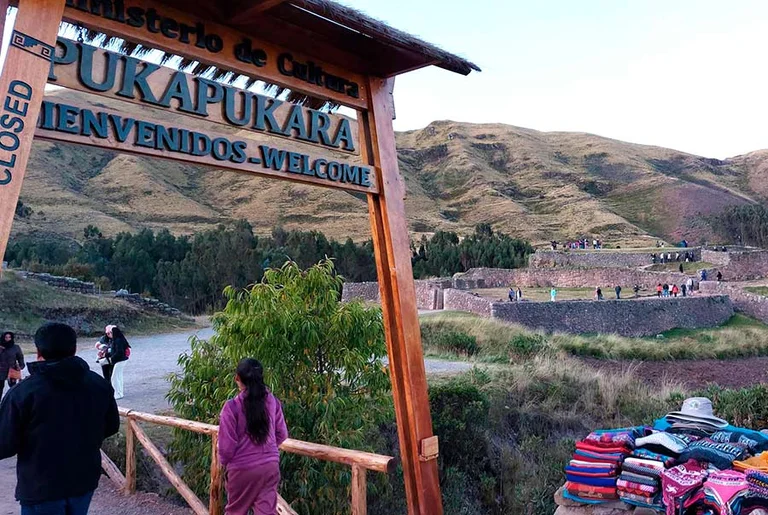
How to get to Puka Pukara
Where exactly is Puka Pukara located?
Puka Pukara is located about 7 kilometers northeast of the historic center of Cusco, in the province of Cusco, region of the same name. It sits at an approximate altitude of 3,580 meters above sea level.
This fortress is very close to other important archaeological sites such as Tambomachay, with which it forms part of a heritage complex. Its location was not only strategic in Inca times, but it also makes it a key stop today within the traditional “Cusco City Tour,” a tourist route that includes several nearby destinations.
Note: Traveler, it’s very important to keep in mind that the Tourist Ticket only gives you access to the archaeological sites, but does not include additional services such as transportation or a guide. If you want to make the most of this ticket, it is recommended to hire a travel agency that offers the City Tour service, with which you can visit Sacsayhuamán, Qenqo, Puka Pukara, Tambomachay, and Qoricancha in a single 4-hour tour.
How to get there from downtown Cusco?
There are several ways to get from downtown Cusco to Puka Pukara. The most common is to take public transportation or a taxi to Tambomachay, since both sites are practically next to each other, separated by only a few meters. The ride takes about 15 to 20 minutes, depending on traffic.
How much does transportation to Puka Pukara cost?
The transportation cost varies depending on the option chosen. If you take a taxi from downtown Cusco to Puka Pukara, the average price ranges between 20 and 30 soles per trip. This may vary slightly depending on the time of day or if you negotiate the fare directly with the driver.
If you prefer to use public transport, you can take a minibus (combi) going to Pisac or Tambomachay from Tullumayo Avenue or the Puputi bus stop. The fare usually ranges between 1 and 2 soles. However, this type of transport will drop you off on the highway, so you’ll need to walk a few minutes to the entrance of Puka Pukara.
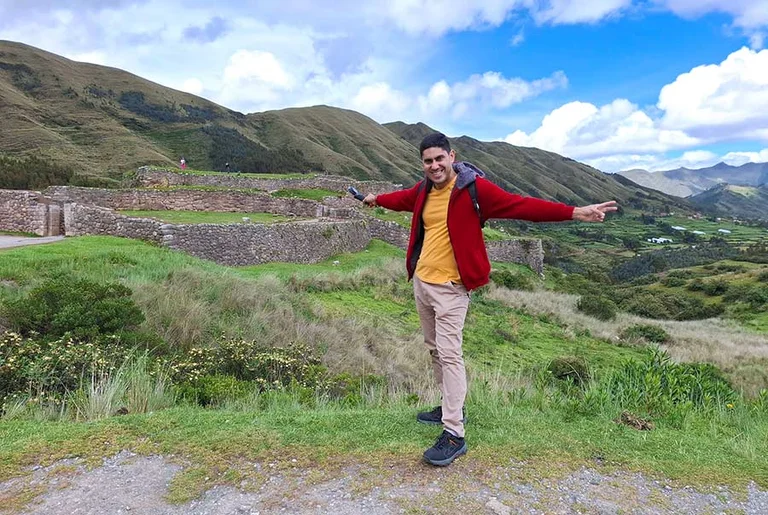
Schedules, prices, and tickets
What are Puka Pukara’s opening hours?
Puka Pukara is open every day, including holidays, with typical hours from 8:00 a.m. to 6:00 p.m. according to most official sources, including local archaeological administrations. These hours allow you to visit in the morning or at sunset, with good lighting to enjoy the panoramic view.
It’s recommended to arrive early, around 8:00 a.m., or close to closing time to find the site quieter and avoid crowds. The schedule allows flexibility when planning longer itineraries that include nearby sites such as Sacsayhuamán, Q’enqo, and Tambomachay.
Is it included in the Cusco Tourist Ticket?
Yes. Puka Pukara is included in the Circuit I of the Cusco Tourist Ticket, along with Sacsayhuamán, Q’enqo, and Tambomachay. This means that with the corresponding partial ticket or the full ticket, you can enter without buying another admission.
The Tourist Ticket is a personal and non-transferable pass designed to allow visits to one or more archaeological circuits and museums within the department of Cusco. Keep in mind that the ticket does not include guide or transportation services — it only grants access to the sites.
Where to buy tickets?
The Cusco Tourist Ticket can be purchased at the main COSITUC office, located at Av. El Sol 103, office 101 (Tourist Galleries). There are also sales points at the archaeological sites themselves, such as Sacsayhuamán or Puka Pukara, although it’s recommended to buy in advance to avoid any entry delays.
Another very convenient option is to book your ticket in advance online at ticketcusco.com, the authorized travel agency where you can secure your entry safely and ahead of time. From there, you can get clear information about the circuits and personalized assistance if you have any questions.
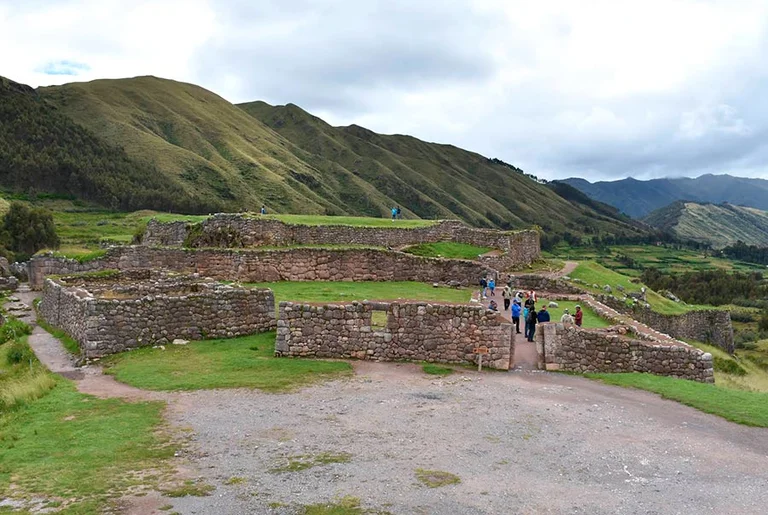
Traveler tips
What to bring for the visit?
To visit Puka Pukara, it’s recommended to wear comfortable and lightweight clothing. Don’t forget to bring a windbreaker or rain jacket, since while days can be sunny, sudden rain showers can occur — especially during the rainy season. Footwear should be suitable for walking on uneven surfaces, preferably trekking shoes.
It’s also important to bring a bottle of water, sunscreen, a hat or cap, and sunglasses. If you visit in the afternoon, a small snack can be useful, as there are no stores inside the archaeological site. Lastly, don’t forget your Tourist Ticket, since this site is part of the Cusco Tourist Ticket circuit, which is required for entry.
Best time of year to visit
The best time of year to visit Puka Pukara is during the dry season, from April to October. During these months, there’s less chance of rain, and days are usually sunny, making it perfect for walking and taking photos with clear skies.
Although it’s possible to visit the site during the rainy season (from November to March), you should be prepared for sudden showers. If you choose to go during these months, it’s best to visit in the morning, since rainfall tends to be heavier in the afternoon.
Is it recommended to go with children or older adults?
Yes, visiting Puka Pukara can be suitable for both children and older adults, as long as they are in good health. The site doesn’t have long or very steep paths, so it’s not as physically demanding as other archaeological routes. However, since it’s located at over 3,500 meters above sea level, it’s important to take precautions against altitude sickness.
For a comfortable visit, it’s recommended to go slowly, take breaks, and bring water — especially for older adults. It’s also ideal to have a walking stick or trekking poles for extra stability. For children, it can be an educational and fun experience if combined with a good explanation of the site’s history and enough time to explore without rushing.
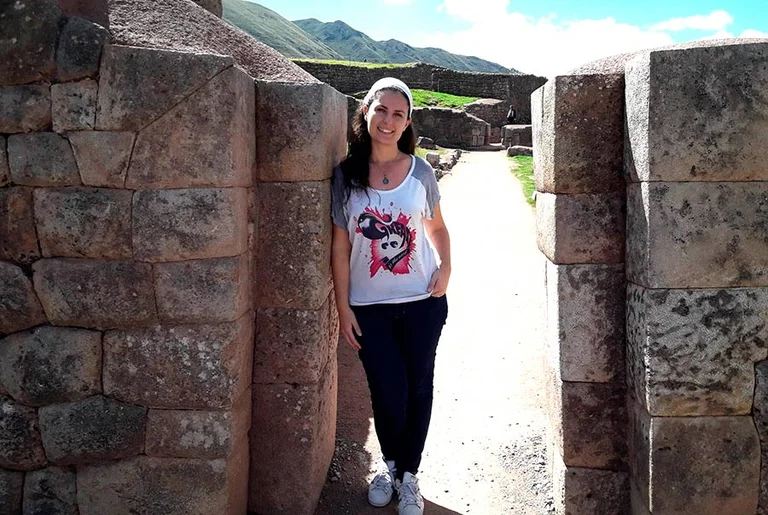
Frequently asked questions
1. What does Puka Pukara mean in Spanish?
Puka Pukara means “red fortress” in Quechua. The name refers to the reddish hue its stones take on at sunset.
2. What is the altitude of Puka Pukara?
Puka Pukara is located at about 3,580 meters above sea level. Since it is at a higher altitude than the city of Cusco, it’s recommended to be acclimated before visiting.
3. Is Puka Pukara part of the Cusco City Tour?
Yes, Puka Pukara is part of the traditional Cusco City Tour route. It’s usually visited together with Sacsayhuamán, Qenqo, and Tambomachay in a single half-day tour.
4. Can I visit on my own or do I need a guide?
You can go on your own; hiring a guide is not mandatory. However, having a guide will help you better understand the history of the site, as there are no explanatory panels inside.
5. How long does it take to get there from Cusco?
From downtown Cusco, the trip to Puka Pukara takes between 25 and 30 minutes by vehicle. You can also walk, though good physical condition is recommended due to the altitude.
6. What clothes should I wear for the visit?
It’s best to wear comfortable and lightweight clothing that protects you from either the cold or the sun, depending on the weather. Don’t forget a windbreaker jacket, hat, sunscreen, and proper footwear for walking on stone surfaces.
7. Are there restrooms at Puka Pukara?
At the archaeological site itself, there are no restrooms available. Generally, the nearest facilities are located at Tambomachay, just a few meters away.
8. Is it open every day of the year?
Yes, Puka Pukara is open every day of the year, including Sundays and holidays. Restrictions may only occur in exceptional cases, such as maintenance or official events.
9. Can you visit with pets?
It’s not recommended to visit Puka Pukara with pets, as it is a protected archaeological site. In addition, there are no designated areas for animals or services for their care.
10. What other archaeological sites are nearby?
Very close to Puka Pukara is Tambomachay, just a few steps away. You’ll also find Qenqo and Sacsayhuamán, all located along a route easily explored as part of the Cusco City Tour.